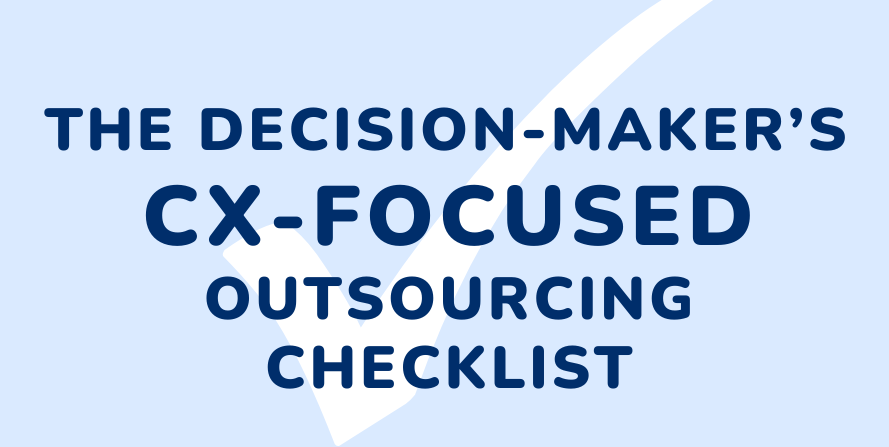Read Time: 11 minutes
Table of Contents
Introduction
Many people will use the terms “customer service” and “customer experience” interchangeably. However, these are two separate parts of how you interact with your customers. Customer service is a part of the customer experience, yes, but it’s important to understand the difference between the two, as this provides your business the clarity you need to select the right outsourcing partner.
Key takeaways
- Customer experience is proactive, customer service is reactive: Customer experience is an actively cultivated part of your company’s culture and the holistic perception you foster for customers in each interaction. Customer service, while trained and planned for, happens in response to customers’ needs and questions.
- Choose a partner based on your CX strategy: Outsourcing success depends on selecting an outsourcing partner who is aligned with your CX strategy, outfitted to meet your specific needs.
- Questions to ask potential partners: As you vet potential CX outsourcing partners, it’s important to ask many questions, gauging their understanding of your brand, their expertise and abilities in handling clients, and what measures they have in place to ensure continuous improvement.

What’s the real difference between customer experience and customer service?
Before you start looking to outsource your customer care, it’s critical to grasp the differences between customer service and customer experience. By knowing the distinction, you ensure that you have the necessary vocabulary to understand what potential partners are actually offering and if it suits your needs.
Defining customer service
Customer service is the reactive support that agents provide to your customers. Typically, this means answering questions, complaints, and general inquiries regarding everything from billing to tracking orders to resetting passwords. Customer service is also typically issue-specific, and its quality can be measured through more tactical metrics, such as Average Handle Time (AHT), First Contact Resolution (FCR), and Customer Satisfaction (CSAT).
Defining customer experience (CX)
Conversely, customer experience is the overall perception that the customer leaves with after interactions with your brand. Everything from the usability of your website to the support customers receive after purchases. CX is the big-picture, proactive things your company does or plans to do to foster positive impressions in your customers and encourage long-term loyalty. Success in CX is better measured by long-term, big-picture metrics, such as Net Promoter Score (NPS) and Customer Lifetime Value (CLV).
Why this distinction matters in outsourcing
When you outsource, it’s vital to make the distinction between customer service and customer experience, as it prevents short-sighted decision-making. Most outsourcing vendors will promise “great service,” but if they don’t have the structure to deliver on that promise, it can be very difficult for them to provide you with a consistent and strategic customer experience. Just because your call resolution is high, that doesn’t necessarily mean that those interactions have merited you a loyal customer. When an outsourcing provider doesn’t have CX at the top of their priorities, it makes the whole process feel much more transactional than relationship-building.
Want to scale your business?
Global Response has a long track record of success in outsourcing customer service and call center operations. See what our team can do for you!
Service metrics don’t guarantee experience quality
Even if you mark off every KPI with flying colors, providing quick answers, handling customers quickly, and gaining high CSAT scores, there’s still the possibility of losing long-term customer loyalty. That may seem odd at first glance, but the reason is that how you do something matters just as much as what you’re doing. Perhaps your agents are solving customer problems, but doing so in a robotic manner that makes the interaction feel stilted, even when it achieves its goals. Efficiency is important, but has to be countered with meaningful interactions and a personal touch.
Risks of choosing the wrong BPO partner
Offloading tasks isn’t the only thing to worry about when you choose a BPO partner. Trusting another company with your brand voice and customer experience can feel vulnerable when done without a plan, and that’s because a BPO that is a bad match can cause problems that damage both customer relationships and your brand image. Here are three of the biggest risks that decision-makers need to consider before signing a contract.
Misaligned KPIs
If a BPO only seems focused on the most basic KPIs, such as average handle time or cost per contact, that might indicate that they are missing out on the larger question of customer experience, which is, “How do customers feel after an interaction with your brand?”
Success in CX is dependent on measuring CX KPIs beyond basic efficiency metrics. When a partner isn’t aligned with the goals you have for customer experience and doesn’t bother with metrics like NPS, customer sentiment, or brand loyalty, that may be an indication that they will deliver service that is technically correct, but ultimately feels disconnected from your customers and their actual feelings.
Brand Voice Inconsistency
When you have an outsourced team, it’s not uncommon for them to be the only real, direct human contact that your customers usually have with your company. With that being the case, it becomes all the more important for those interactions to be reflective of the unique voice and values that your brand prides itself on. If a BPO doesn’t have thorough training, close monitoring, and proper brand alignment, it can result in a watered-down version of your brand voice or even go in direct opposition to it, which can be jarring to your customers.
READ MORE: The Importance of Brand Consistency (and how the right call center partner can help!)
Lost Customer Loyalty
Loyalty takes time to build, but it can be gone in a flash if you aren’t careful. Even a single negative experience can turn a customer from a promoter to a detractor, undoing years of positive feelings. For that reason, it’s important to select an outsourcing partner carefully, as the wrong one can cause enough friction and carelessness to erode customer trust and create customer attrition issues that are hard to reverse.
The decision-maker’s CX-focused outsourcing checklist
Not every BPO provider is built with CX in mind. Though most will promise efficiency, not as many are able to provide the valuable emotional intelligence, brand continuity, or customer journey design that it takes to build a powerful customer experience. Here, we’ve included a practical checklist to help your organization properly assess a potential partner’s capability of delivering customer experience excellence.

Download our Decision Maker’s CX-Focused Outsourcing Checklist now to help evaluate which BPO partner to choose.
Pre-evaluation questions
Before you hone in on a potential provider, it’s important to look inward. Ask yourself and any other stakeholders in your organization these important questions to determine what you should be looking for in an outsourcing partner for the best long-term customer experience results.
Do they understand our brand voice and tone?
Any customer service agents you outsource to should ideally act as an extension of your brand, both in voice and in action. Do any of your prospective partners show that they understand your brand’s unique personality? Do they seem capable of adapting their approach to match your voice across every channel?
What CX metrics do they measure beyond CSAT?
Customer Satisfaction (CSAT) is a useful metric, but it only gives you one small chunk of the story. If a prospective partner is truly serious about quality customer experiences, they will ideally be tracking other metrics as well, such as Net Promoter Score (NPS), Customer Effort Score (CES), customer sentiment analysis, and retention rates. All of these indicators together paint a fuller picture of how easy, memorable, and loyalty-building each of your customer interactions is. When vendors can’t show how they track and improve these areas, it’s a strong indication that they are more focused on the technical, formulaic services, not on a holistic customer experience.
Vendor evaluation criteria
This is where you distinguish the potential partners who are true customer experience providers from those who are merely basic service vendors. The correct BPO should give you more than just manpower and procedures. Ideally, they’ll also have strong strategic insights, a culture of empathy, and tools that integrate with your ideal customer journey.
Customer journey mapping capabilities
To better manage the customer experience, it’s vital to understand the whole customer journey, not just single customer support calls. Be sure to ask the vendor if they provide customer journey mapping, which allows them to more reliably identify the points in the process that have the highest stakes or that have the highest potential for friction. Partners who visualize customer relationships more holistically in terms of journeys and not just single transactions are more likely to provide great customer experiences that lead to better outcomes.
Omnichannel integration and personalization
Customers expect to be able to interact with your brand at any time, from any place. Is your BPO capable of providing omnichannel support from a variety of channels like phone, chat, email, SMS, social media, and others, all without making customers repeat themselves to multiple agents? Do they have the ability to use context and customer history to inform interactions and provide a greater deal of customization?
Agent training for empathy and experience
Two of the most important things to look for in outsourcing partners are their technical skills and product knowledge, but alone, those are not enough. Be sure to ask potential BPO partners what kind of training they offer in topics like empathy, emotional intelligence, and active listening. See if their agents are coached to recognize the subtler signs of customer frustration, how to adapt to different customer personalities, and how to best create a friendly, helpful, and human-centered experience. The best CX will come from agents who are emotionally aware and who treat each customer like an individual instead of a task.
Post-onboarding insights
Once you’ve successfully launched your outsourcing relationship, be sure to continuously evaluate your partner’s capabilities, especially as they pertain to growing and evolving with your needs post-launch.
What’s their feedback loop process?
After the launch, your partner should make use of structured feedback loops to ensure quality and make improvements whenever necessary. Ask your partner about their process for collecting insights from agents, gathering customer feedback, and any QA data, as well as their process for acting on that data. Are they capable of uncovering patterns or identifying frequent issues? Ideally, your BPO partner should be able to act intelligently on feedback and close the loop with smart improvements to their approach.
Can they co-own CX improvement KPIs?
The best BPO vendors aren’t just blindly checking the minimum boxes, but will share ownership of your customer experience outcomes. Ask your partner how they invest themselves in the process of improving NPS, reducing customer churn, and boosting overall customer loyalty. A healthy co-ownership will emphasize the long-term consequences of customer interactions, not merely speeding through each one.
Final thoughts: Service is a feature, CX is a strategy
Outsourcing isn’t as simple as handing off a task or two, but it is most effective when you entrust your outsourcing partner with managing your customer relationships. Before outsourcing, get to know your partner’s history and abilities when it comes to CX, ensuring that they know how to behave as a true extension of your brand, provide tailored customer interactions, and turn your customer experience into the ultimate competitive advantage.
FAQs
Customer experience is the entire journey a customer has with a company, while customer service is just one specific stop on that journey.
Customer service plays a pivotal, and often memorable, role within the overall customer experience. A single positive or negative customer service interaction can significantly color a customer’s entire perception of a brand.
Customer experience is a far broader and more strategic concept than customer service because it encompasses every single touchpoint a customer has with a brand.
Not very likely. While a customer might be satisfied with the product itself, a negative customer service interaction can leave a lasting and powerful negative impression that sours the entire perception of the brand.




